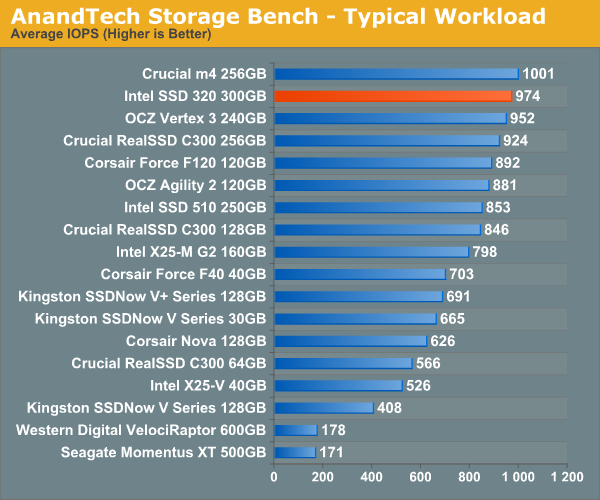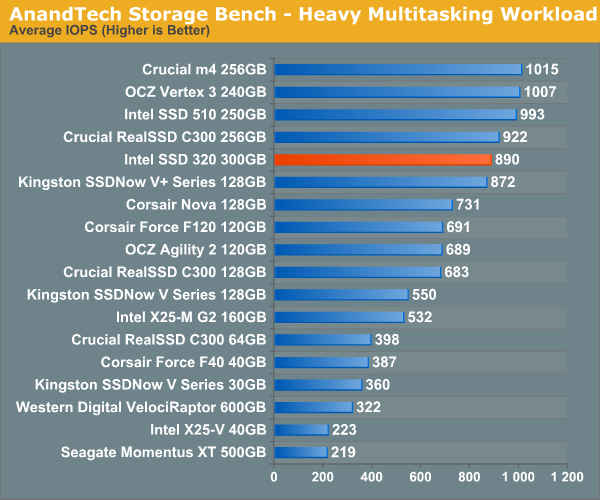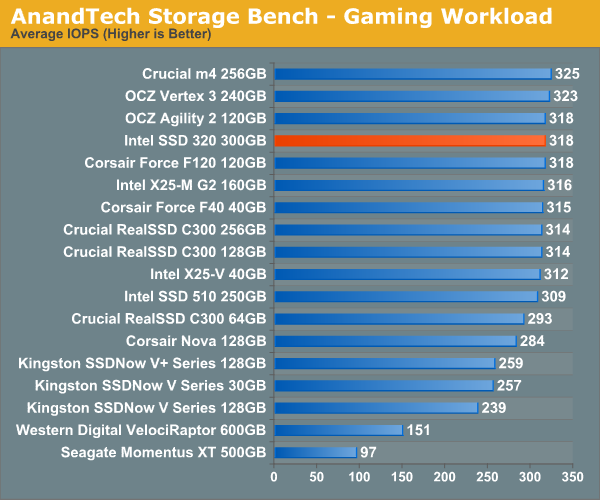The Intel SSD 320 Review: 25nm G3 is Finally Here
by Anand Lal Shimpi on March 28, 2011 11:08 AM EST- Posted in
- IT Computing
- Storage
- SSDs
- Intel
- Intel SSD 320
AnandTech Storage Bench 2010
To keep things consistent we've also included our older Storage Bench. Note that the old storage test system doesn't have a SATA 6Gbps controller, so we only have one result for the 6Gbps drives.
The first in our benchmark suite is a light/typical usage case. The Windows 7 system is loaded with Firefox, Office 2007 and Adobe Reader among other applications. With Firefox we browse web pages like Facebook, AnandTech, Digg and other sites. Outlook is also running and we use it to check emails, create and send a message with a PDF attachment. Adobe Reader is used to view some PDFs. Excel 2007 is used to create a spreadsheet, graphs and save the document. The same goes for Word 2007. We open and step through a presentation in PowerPoint 2007 received as an email attachment before saving it to the desktop. Finally we watch a bit of a Firefly episode in Windows Media Player 11.
There’s some level of multitasking going on here but it’s not unreasonable by any means. Generally the application tasks proceed linearly, with the exception of things like web browsing which may happen in between one of the other tasks.
The recording is played back on all of our drives here today. Remember that we’re isolating disk performance, all we’re doing is playing back every single disk access that happened in that ~5 minute period of usage. The light workload is composed of 37,501 reads and 20,268 writes. Over 30% of the IOs are 4KB, 11% are 16KB, 22% are 32KB and approximately 13% are 64KB in size. Less than 30% of the operations are absolutely sequential in nature. Average queue depth is 6.09 IOs.
The performance results are reported in average I/O Operations per Second (IOPS):

If we strip 6Gbps out of the equation completely, the SSD 320 does very well in our old light workload. You're looking at performance that's at the top of the pack from the mainstream offering.
If there’s a light usage case there’s bound to be a heavy one. In this test we have Microsoft Security Essentials running in the background with real time virus scanning enabled. We also perform a quick scan in the middle of the test. Firefox, Outlook, Excel, Word and Powerpoint are all used the same as they were in the light test. We add Photoshop CS4 to the mix, opening a bunch of 12MP images, editing them, then saving them as highly compressed JPGs for web publishing. Windows 7’s picture viewer is used to view a bunch of pictures on the hard drive. We use 7-zip to create and extract .7z archives. Downloading is also prominently featured in our heavy test; we download large files from the Internet during portions of the benchmark, as well as use uTorrent to grab a couple of torrents. Some of the applications in use are installed during the benchmark, Windows updates are also installed. Towards the end of the test we launch World of Warcraft, play for a few minutes, then delete the folder. This test also takes into account all of the disk accesses that happen while the OS is booting.
The benchmark is 22 minutes long and it consists of 128,895 read operations and 72,411 write operations. Roughly 44% of all IOs were sequential. Approximately 30% of all accesses were 4KB in size, 12% were 16KB in size, 14% were 32KB and 20% were 64KB. Average queue depth was 3.59.

Crank up the workload and the 320 falls a bit behind the rest of the competitors. Last year's heavy multitasking workload is nothing compared to what we introduced earlier this year, so it's still pretty light by comparison but it's clear for normal usage the 320's 3Gbps performance is quite good.
The gaming workload is made up of 75,206 read operations and only 4,592 write operations. Only 20% of the accesses are 4KB in size, nearly 40% are 64KB and 20% are 32KB. A whopping 69% of the IOs are sequential, meaning this is predominantly a sequential read benchmark. The average queue depth is 7.76 IOs.











194 Comments
View All Comments
anthonyjcho - Thursday, November 17, 2011 - link
I just got the 40GB version of this drive for my work computer as a cache drive.I have a large DB files (1-2GB) that I access frequently and I needed a "reliable" SSD for my task. Crucial and Intel came to mind, and only Intel products could be sourced. By the way, I use a OCZ SSD at home for gaming for better read performance.
Long story short,
100-105 MB/s for Read/Write is drastic improvement over the 7200rpm HDD I was using.
My work is much more productive because I don't have to wait so long for data retrieval anymore.
I highly recommend it to any data analyst.
spacehead74 - Thursday, January 5, 2012 - link
I've been finding these on Ebay for less than $200/160gb. The 5-year warranty is a great selling point when using these for laptop upgrades.sqeeek - Thursday, October 2, 2014 - link
Still using two of these as of October 2014. Not the fastest sequential r/w but the random reads + low latency are still mind-blowingly fast compared to a spinning disk. Reliability is great as well - I even bought one used.DocSportello - Monday, September 21, 2015 - link
I installed my 320 in early 2012, and it's still running strong. My first (and thus far only) SSD, so it was a huge step up from HDs.If the numbers I saw at the time were to be believed, 320's were significantly more reliable than the alternatives. I got a bit spooked by those ongoing reports of 8-megabyte crashes; was it just a matter of time until that happened to me? But those reports mostly involved a system crash and usually a power loss; that's rare for me on a desktop with a quality power supply and a UPS.
Anyway, for whatever reason, my 320 is doing well. The specs claimed a million hours MTBF; what did the real numbers turn out to be? Oddly, the SSD Toolbox shows less than a thousand hours of power-on time, which would be unbelievably low, except I saw a post somewhere suggesting that that number is more a count of read/write activity than powered on and ready.
If I were buying today, I'd look at a Samsung 850, figuring the 40 nm cells have got to be inherently more robust than today's typical 19 nm cells. But that's theory; meanwhile the Intel 320 keeps rolling along.